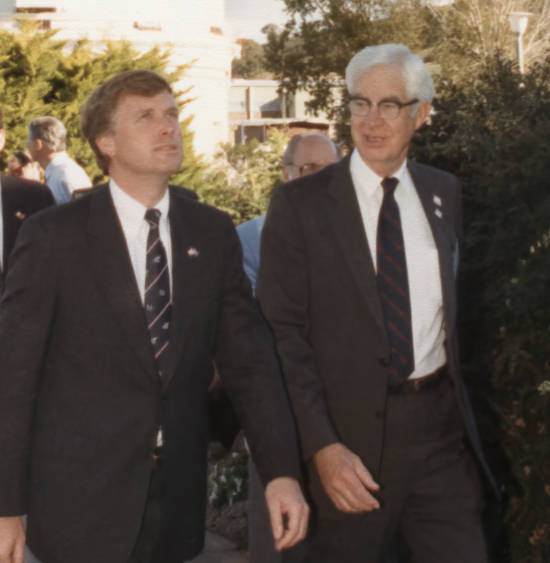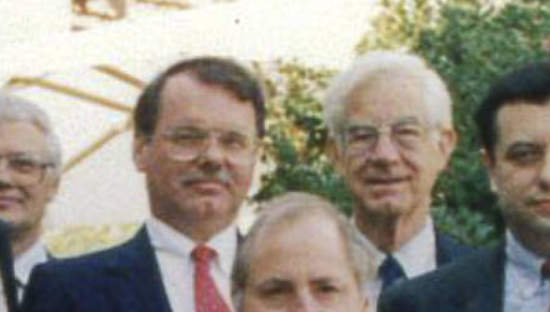NASA Senior Representative to Australia Charlie Taylor (right) with United States Vice President Dan Quayle at Tidbinbilla on 27 April 1989, the day before Taylor’s 70th birthday. Cropped from a scan by Glen Nagle.
Charles A. Taylor
1919 – 2013
NASA Senior Representative to Australia, 1986–1990, briefly in 1992.
NASA Senior Representative to Australia Charlie Taylor (right) with United States Vice President Dan Quayle at Tidbinbilla on 27 April 1989, the day before Taylor’s 70th birthday. Cropped from a scan by Glen Nagle. |
Charles Alvin Taylor was born in Jefferson, Georgia, on 28 April 1919. He was the third of five children.
The family moved often in his early years, spending time in the Carolinas and in northwestern Florida before settling in the town of DeFuniak Springs, 50km ENE of Pensacola, Florida. It was here that Charles completed high school.
After high school, he first attended Mars Hill Junior College in Mars Hill, North Carolina, and then the Georgia Institute of Technology in Atlanta. He worked his way through as a ‘co-op’ student, alternately attending classes and taking engineering jobs in three month shifts. He received his bachelor’s degree in Electrical Engineering from Georgia Tech in 1942.
Subsequent to his graduation, he was employed at the Langley Research Center of the National Advisory Committee for Aeronautics (NACA) in Hampton, Virginia. Here, he was involved in research and development on instrumentation for high speed aircraft and rockets from 1942 to 1955.
After thirteen years with NACA, Charlie moved to the Burroughs Corporation in Paoli, Pennsylvania from 1955 to 1962, and then General Electric’s Missile and Space Division in Valley Forge, Pennsylvania.
He joined NACA’s successor, NASA, in November 1968.
At NASA, Taylor became Director of Operations, Communications, and ADP Division, OTDA (Office of Tracking and Data Acquisition). There he was responsible for management and direction of operations of OTDA facilities and had functional responsibility for all NASA Automatic Data Processing. He was with NASA for Apollos 8 to 17, Skylab, ASTP and the first Shuttle missions.
He retired in 1982 as Director of the Network Systems Division of NASA’s Office of Space Tracking and Data Systems.
Charlie and his wife Nancy moved back to DeFuniak Springs. He had taken early retirement due to her ill health. Sadly, Nancy died in 1983.
Charlie met Alice, through volunteer work he was doing in Pensacola. They married in 1985 and, in 1986, he came out of retirement to be appointed NASA’s Senior Representative in Australia. Charlie and Alice spent four very enjoyable years in Canberra, offically retiring (again) in 1989.
In 1992, Charlie returned to Australia for several weeks. Ted Ankrum, NASA Representative 1992 – 1997, explains,
“One of the things that had happened during [NASA Rep Dick Colonna’s] tenure was to provide NASA funding to the State Department to purchase a house for the NASA Rep. It is the practice of the US Government to provide housing for its overseas personnel and prior to this, the NASA Rep was assigned whatever house the Embassy’s Admin section was able to lease at the moment. Dick had argued that NASA would be better served with a dedicated house and that NASA should provide funds to the State Dept to buy a house, which happened during Dick’s tenure. But, this meant ‘a’ house, not ‘the’ house that Dick had picked out and the Embassy had purchased. Prior to his departure and my arrival date, Dick arranged for Charlie Taylor to be the ‘temporary’ NASA Rep and squat in the ‘NASA House’ to preserve it as the NASA Rep’s housing.”
Thus, Charlie Taylor was back in Canberra for the DSN Joint Management Meeting in April 1992.
Ted Ankrum and Charlie Taylor both attended the Deep Space Network Joint Management Meeting at Hotel Ainslie in Canberra, in April 1992. |
After a short illness, Charlie Taylor died in Pensacola, Florida, in January 2013, having witnessed milestones in aeronautical and rocket development at NACA and NASA, including the Apollo missions through to the end of the Shuttle program.
These References are gratefully acknowledged:
Charles Taylor Obituary, Legacy.com, first published by The Pensacola News Journal on 3 February, 2013.
NASA Apollo 11 Press Kit – page 213. (Thanks to Mike Dinn for the tip.)
Notes by G. Ted Ankrum.

